#groundwater
Photo
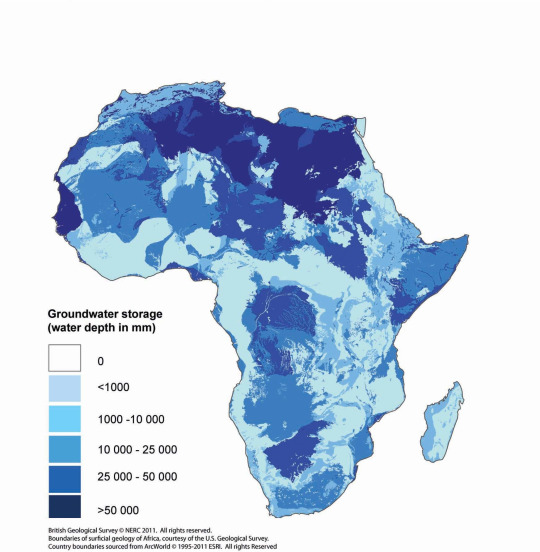


Groundwater across Africa.
283 notes
·
View notes
Text
Earth's tilt has changed by 31.5 inches (80 centimeters) between 1993 and 2010 because of the amount of groundwater humans have pumped from the planet's interior.
In that period, humans removed 2,150 gigatons of water from natural reservoirs in the planet's crust. If such an amount was poured into the global ocean, its surface would rise by 0.24 inches (6 millimeters). A new study has now revealed that displacing such an enormous amount of water has had an effect on the axis around which the planet spins.
Scientists arrived at this conclusion by modeling the changes in the position of Earth's rotational pole, the point at which the planet's imaginary axis would stick out of the surface if it were a physical object. The position of the rotational pole is not identical with the geographical north and south poles and actually changes over time, so the rotational axis cuts through different spots on the planet's crust at various points in time.
...
"Earth's rotational pole actually changes a lot," Ki-Weon Seo, a geophysicist at Seoul National University who led the study, said in a statement. "Our study shows that among climate-related causes, the redistribution of groundwater actually has the largest impact on the drift of the rotational pole."
Continue Reading
683 notes
·
View notes
Text
youtube
You can grow tanks, rather than buy them, and they'll have a lot more water-harvesting capacity.
This video is about how living sponges (rain gardens) have far greater capacity than non-living manufactured water tanks, in that they utilize and infiltrate water during and immediately after rains to quickly make more room or capacity for the next rain - even if that rain comes just a few hours after the first rain.
Thus rain gardens (in this case, a water-harvesting, traffic-calming chicane or pull out) typically have much more potential for flood-control, groundwater-recharge, bioremediation (natural filtration of toxins), and heat-island abatement (due to the shading/cooling vegetation they grow and the cooling effect of the water transpiring through these "living pumps").
This works in any climate, but the vegetation changes as you change bioregions. The easiest path to success is to use plants native or indigenous to your area and site's microclimate. Go further, and select native plants that also produce food, medicine, craft/building materials, etc so you grow living pantries, pharmacies, craft suppliers, etc.
At minimum, make sure your tanks overflow to rain gardens, so that overflow is used as a resource. And place those rain gardens and their vegetation where you most need that vegetation, such as trees on the east and west sides of buildings to shade out the morning and afternoon summer sun for free, passive cooling.
The ideal, is that once this rain garden vegetation has become established the only irrigation water it will require is the freely harvested on-site water, so no importing/extracting of groundwater, municipal water, or other is needed. This way we can infiltrate more water into the living system than we take out - thereby enabling the recharge of groundwater, springs, and rivers; instead of their depletion and dehydration.
Get more info on how to do this and harvest many other free, on-site waters at:
https://www.harvestingrainwater.com/
where you can buy Brad's award-winning books, "Rainwater Harvesting for Drylands and Beyond" at deep discount direct from Brad at:
https://www.harvestingrainwater.com/s...
For more info on the community water harvesting and native food forestry work check out:
https://dunbarspringneighborhoodfores...
For more videos that expand on this one subscribe to this channel at:
http://www.youtube.com/user/Harvestin...
#rainwater
#waterharvesting
#permaculture
#rainwaterharvesting
#Brad Lancaster#solarpunk#permaculture#rain garden#water#rainwater harvesting#rainwater#water harvesting#rain water harvesting#rain water#garden#plants#native plants#native species#groundwater#Youtube
560 notes
·
View notes
Text
Some of the world’s largest investment banks, pension funds and insurers, including Manulife Financial Corp.’s John Hancock unit, TIAA and UBS, have been depleting California’s groundwater to grow high-value nuts, leaving less drinking water for the surrounding communities, according to a Bloomberg Green investigation. Wall Street has come to Woodville, wringing it dry. Since 2010, six major investors have quadrupled their farmland under management in California, to almost 120,000 acres in all, equivalent to a third of all the cropland in Connecticut.
[...]
This rush for water is an outgrowth of a decades-long bet on farmland by investors who see food cultivation as an asset class virtually assured of appreciating in a warming, more populous world. Globally, large investors and agribusinesses have snapped up about 163 million acres of farmland in more than 100 countries in the past 20 years. The land grab has given rise to a grab of an even scarcer global commodity: water. In a bid to ensure thriving investment portfolios, some of the world’s largest financial entities have amassed control over lakes, rivers and underground aquifers in places from California to Africa, Australia to South America, giving them outsize roles in managing an endangered resource that’s the basis of life on Earth. The trend has contributed to shifting hydrological patterns that stand to permanently disrupt communities’ access to fresh water. Local populations are paying the price in drained wells, high water bills and contaminated water supplies.
[...]
In the past decade, parts of the San Joaquin Valley have dropped as much as a foot per year, according to the US Geological Survey. Subsidence, as the sinking is called, has damaged bridges, canals and other infrastructure that will cost billions of dollars to fix, the state says. The aquifers themselves are irreparable. Many groundwater basins, when drained, never recover their former storage capacity, hydrologists have found. “Groundwater in California has been treated as an extractive resource—you pump and hope for the best,” says Graham Fogg, an emeritus professor of hydrology at the University of California at Davis. “Capitalism is driving this. Investors don’t care, because in 10 years they can make all the money they want and leave.”
85 notes
·
View notes
Text
I fucking love water cycle graphs vote on your favorite water cycle graph NOW (ESA, NOAA, USGS respectively)
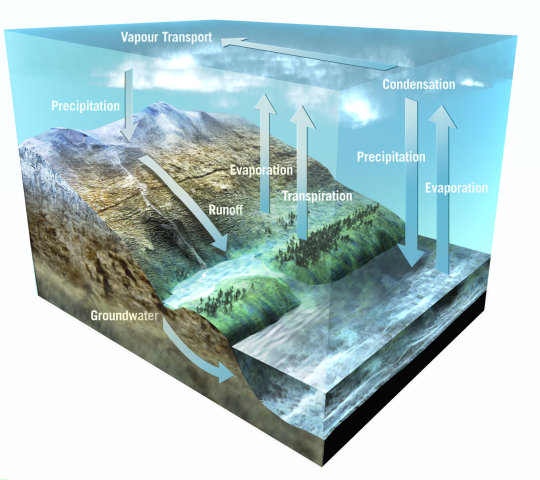
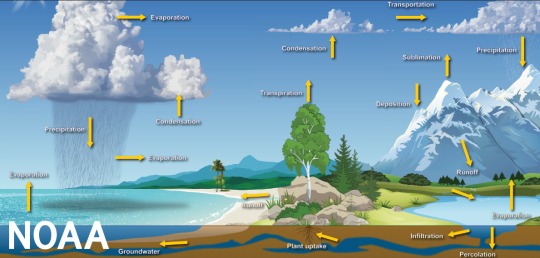

#water cycle#lakeposting#lake#poll#ocean#water#precipitation#rain#river#hydrology#groundwater#noaa#esa#usgs#science#environment#chemistry#nature#outdoors
420 notes
·
View notes
Text
As you take away trees, and their deep roots die with them, the subterranean water rises, carrying salt with it.
"Soil: The incredible story of what keeps the earth, and us, healthy" - Matthew Evans
#book quote#soil#matthew evans#nonfiction#trees#deforestation#land clearing#groundwater#salinity#soil salinity#salination#salt
14 notes
·
View notes
Text
No paywall.
24 notes
·
View notes
Text
2nd session, 14th Meeting of the Task Force on Water and Climate.
The fourteenth meeting of the Task Force on Water and Climate aims to discuss, plan and provide guidance to the implementation of the activities on Water diplomacy and Climate change under the programme of work for 2022-2024 of the Water Convention as well as to the planned activities under the next programme of work for 2025-2027 of the Water Convention. UN Web TV
Watch the 2nd session, 14th Meeting of the Task Force on Water and Climate.
#task force#Task Force on Water and Climate#water resources#water management#sdg6#groundwater#water convention#water and climate#climate change#plenary session
8 notes
·
View notes
Text
You know what doesn't exist? Ground water. Water? In the ground? No. No way. That's ridiculous. Do you take me for a fool? Like, how did it get there? Where will it go? Do we know? Of course not. How would we have found out? We didn't. That's because it was made up by the commies. They have us over here thinking about groundwater while they take over my country and obstruct my liberty. Groundwater is un-American.
6 notes
·
View notes
Link
#dam failure#dams#flow visualization#fluid dynamics#groundwater#hydrostatics#physics#porous flow#porous media#science#soil liquefaction
91 notes
·
View notes
Photo
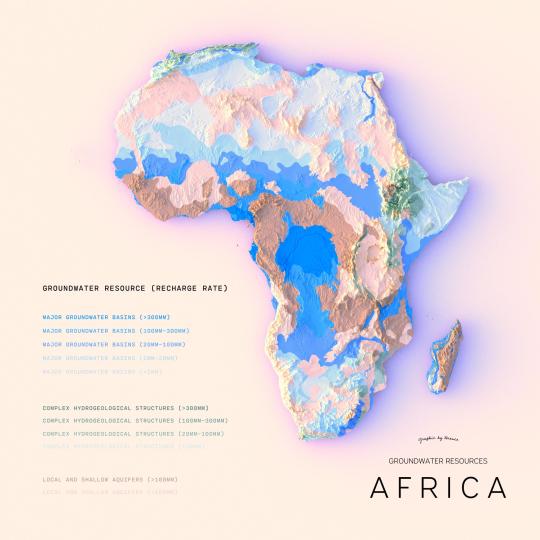
Groundwater resources of Africa
141 notes
·
View notes
Link
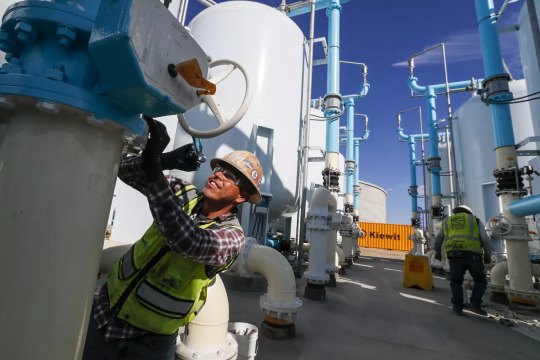
“As drought and climate change ravage California’s once-reliable supply of drinking water, officials in Los Angeles are setting their sights on a relatively new, almost untapped resource for the city’s 4 million residents: the Superfund site in their own backyard.
Nearly 70% of the city’s 115 wells in the San Fernando Valley groundwater basin — the largest such basin under the purview of the Los Angeles Department of Water and Power — have been sitting unused for decades after dangerous contaminants seeped into the aquifer.
Now, the city is nearing the completion of a massive, $600-million plan to bring that resource back online. Centered on three treatment facilities in the San Fernando Valley, the groundwater remediation project will essentially create giant filters for the city’s toxic plume, enabling Angelenos to regain full access to up to 87,000 acre-feet of water each year, or nearly a fifth of what they consume...
The city has long relied on other supplies to get by, including water imported from the Owens Valley, Northern California and the Colorado River via a network of aging aqueducts. But as drought saps those sources, Los Angeles is being forced to fundamentally overhaul its water infrastructure.
Currently, only 10% of the water used by the city is sourced locally. The DWP hopes that will increase to 70% by 2035 as the filtration equipment and other major projects are completed...
In Los Angeles, nearly half of the project money so far — about $310 million of $634 million — has come from state grant funds through Proposition 1, a $7.5-billion water bond passed by voters in 2014...
[Professor] Gold, of UCLA, said the scope and scale of the projects in the San Fernando Valley give him “a tremendous amount of hope” for the city’s water future.
“We’re getting reliable, local water supplies,” he said, “and that’s something we need a lot more of here in the state of California.”” -via Los Angeles Times, 12/12/22
#california drought#california#drought#united states#climate change#climate resilience#water#groundwater#water conservation#los angeles#san fernando valley#good news#hope
26 notes
·
View notes
Text
youtube
Permaculture instructor Andrew Millison journeys to India to film the epic work of the Paani Foundation’s Water Cup Competition and Farmer's Cup Competition. We tour the village of Pemgiri, in Maharashtra, who competed in the 2019 competition to install the most amount of water harvesting structures in a 45 day period, and competed had farmer's groups compete in the Farmers Cup Competition in 2023. Guided by Paani Foundation’s chief advisor, Dr. Avinash Pol, we visit the work and see the effects of a watershed-scale groundwater restoration project that has dramatically improved the lives, economy, ecology and stability of this village, and experience the feeling of deep stability that comes with a healthy and abundant landscape.
Paani Foundation:
https://www.paanifoundation.in/
Digital Map Animation:
https://www.pearlriverecodesign.com/
PERMACULTURE DESIGN COURSE LINK:
https://workspace.oregonstate.edu/cou...
Andrew Millison’s links:
https://www.andrewmillison.com/
https://permaculturedesign.oregonstat...
JOIN THIS CHANNEL to get access to uncut video content and live Q & A sessions:
/ @amillison
SIGN UP FOR MY FREE NEWSLETTER:
https://share.hsforms.com/1X79TznHYRC...
#Andrew Millison#solarpunk#permaculture#Paani Foundation#Water Cup Competition#Farmer's Cup Competition#india#Pemgiri#Maharashtra#water harvesting#rain water#watershed#water table#groundwater#water#organic farming#farming#agriculture#Avinash Pol#Youtube
38 notes
·
View notes
Text
2 notes
·
View notes
Text
Tunneling: Methods and Applications
In the vast realm of civil engineering and infrastructure development, tunneling stands as a pivotal and fascinating aspect. It plays a crucial role in connecting people, places, and resources, allowing for efficient transportation, access to resources, and even scientific exploration. This article delves into the intriguing world of tunneling, exploring various methods, their wide-ranging…

View On WordPress
#Blasting#Construction Safety#EIA#environmental impact#Environmental Impact Assessment#Fault Fractures#Geology#Groundwater#occupational safety#RMR#Rock#Rock Mass Rating#safety#Seismic Activity#Soil#Support Systems#TBM#Tunnel Boring Machine#Tunneling#Tunneling Methods
4 notes
·
View notes